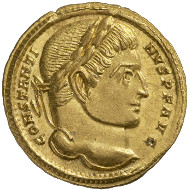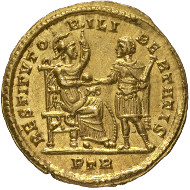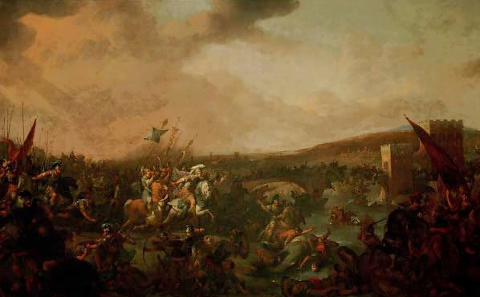with the kind permission of the MoneyMuseum, Zurich
Why is it that for centuries – or rather thousands of years – the head has served as the motif for the side of a coin? And why has this changed in the last 200 years? Ursula Kampmann poses these questions in her book ‘MenschenGesichter,’ from which the texts for our new series are taken.
Roman Imperial Times. Constantine I (307-337). Solidus, Trier, 314. Laureate head of Constantine r. Rev. Constantine, standing right, clad in military garments; to his left goddess Roma is sitting, with helmet, shield and spear; the two of them are holding the globe. © MoneyMuseum, Zurich.
How can say something for sure about a man who lived 2000 years ago? Whether he was good or evil, pious or impious, economically or profligately? Up to the present day, it is hard to get to the bottom of a character of a contemporary – yet, we seem to know much more about the interior life of many a Roman emperor than about the emotions of our fellow human beings.
Constantine, known as the Great, is a case in point. We pretend to know that he considered himself tool of the one, Christian, God and that he was obsessed by the desire for pave the way for the Christians to come to power. But do we really know that?
We have countless records of ancient historians about the personality of Constantine. These historians, however, were Christians and interpreted history according to their own conception: at some point in the not too distant future the kingdom of God would come and a man had to be judged by his actions, whether he had done something to support or rather prevent that from happening. Only a man who supported was considered good, while a man who prevented was bad. He who was good, was completely good, and he who was bad, was completely bad.
Thus, the historians credited Constantine with Christianity’s equality with other religions. To this end, they invented the Edict of Milan which still can be found in our school books. As a matter of fact, Constantine’s co-emperor Galerius had put an end to the prosecution of Christians as early as 311 and granted the Christians equality.
Johann Lingelbach, Battle of the Milvian Bridge, about 1650. Source: Wikicommons.
Another example is the rumor that Constantine had avowed himself a Christian after the victorious Battle of the Milvian Bridge, because he had had a dream the previous night in which a Christian cross appeared to him. For one thing, historians record Christian dreams likewise of Constantine’s opponents without labelling them Christians. And for another thing, if the emperor really was of Christian faith, then he must have been the weirdest of the entire flock. After all, even after his remarkable dream he still had himself depicted on his coins accompanied by his personal tutelary deity, the undefeated sun. We even know of an inscription from that time in which he allows a city to worship his person as deity.
These are only two examples that very much call for methodological caution when adopting the judging of both ancient and modern historians. Many authors follow their own agenda and interpret the actions of a person in a certain way to suit their own notion. Every era writes its own history, over and over again.
In the next chapter we will tell about the nephew of Constantine, Julian, who didn’t take after his father at all but vehemently oppressed the Christians and strengthened the old faith again.
All sections of the series can be found here.
The book ‘MenschenGesichter’ is available in printed form from the Conzett Verlag website. It soon will be translated to English …






